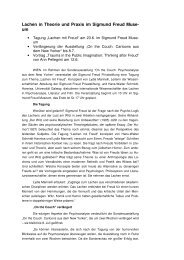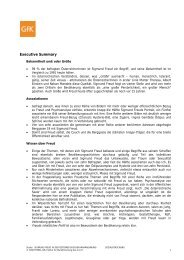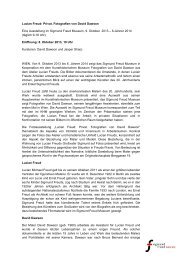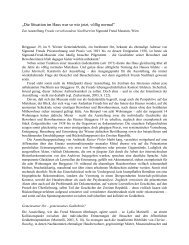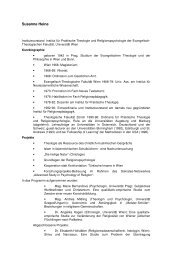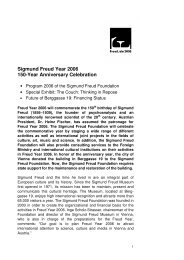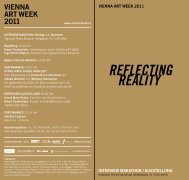Sigmund Freud-Museum | Newsletter - Sigmund Freud Museum Wien
Sigmund Freud-Museum | Newsletter - Sigmund Freud Museum Wien
Sigmund Freud-Museum | Newsletter - Sigmund Freud Museum Wien
Create successful ePaper yourself
Turn your PDF publications into a flip-book with our unique Google optimized e-Paper software.
part of several of the channels, several conversations. ... I’m different in the different chats. They bring<br />
out different things in me.” Identity play can happen by changing names and by changing places.<br />
Even the computer interface encourages rethinking complex identity issues. The development of the<br />
windows metaphor for computer interfaces was a technical innovation motivated by the desire to get<br />
people working more efficiently by “cycling through” different applications much as time-sharing<br />
computers cycled through the computing needs of different people. But in practice, windows have<br />
become a potent metaphor for thinking about the self as a multiple, distributed, “time-sharing” system.<br />
The self is no longer simply playing different roles in different settings, something that people<br />
experience when, for example, one wakes up as a lover, makes breakfast as a mother, and drives to<br />
work as a lawyer. The windows metaphor perhaps merely suggests a distributed self that exists in<br />
many worlds and plays many roles at the same time. Cyberspace, however, translates that metaphor<br />
into a lived experience of “cycling through.”<br />
Identity, moratoria and play. For some people, cyberspace is a place to “act out” unresolved conflicts,<br />
to play and replay characterological difficulties on a new and exotic stage. For others, it provides an<br />
opportunity to “work through” significant personal issues, to use the new materials of cybersociality to<br />
reach for new resolutions. These more positive identity-effects follow from the fact that for some,<br />
cyberspace provides what Erik Erikson would have called a “psychosocial moratorium,” a central<br />
element in how Erikson thought about identity development in adolescence. Although the term<br />
“moratorium” implies a “time out,” what Erikson had in mind was not withdrawal. On the contrary,<br />
the adolescent moratorium is a time of intense interaction with people and ideas. It is a time of<br />
passionate friendships and experimentation.<br />
The adolescent falls in and out of love with people and ideas. Erikson’s notion of the moratorium was<br />
not a “hold” on significant experiences but on their consequences. It is a time during which one’s<br />
actions are, in a certain sense, not counted as they will be later in life. They are not given as much<br />
weight, not given the force of full judgment. In this context, experimentation can become the norm<br />
rather than a brave departure. Relatively consequence-free experimentation facilitates the development<br />
of a “core self,” a personal sense of what gives life meaning that Erikson called “identity.”<br />
Erikson developed these ideas about the importance of a moratorium during the late 1950s and early<br />
1960s. At that time, the notion corresponded to a common understanding of what “the college years”<br />
were about. Today, thirty years later, the idea of the college years as a consequence-free “time out”<br />
seems of another era. College is pre-professional and AIDS has made consequence-free sexual<br />
experimentation an impossibility. The years associated with adolescence no longer seem a “time out.”<br />
But if our culture no longer offers an adolescent moratorium, virtual communities often do. It is part of<br />
what makes them seem so attractive.<br />
Erikson’s ideas about stages did not suggest rigid sequences. His stages describe what people need to<br />
achieve before they can easily move ahead to another developmental task. For example, Erikson<br />
pointed out that successful intimacy in young adulthood is difficult if one does not come to it with a<br />
sense of who one is, the challenge of adolescent identity building. In real life, however, people<br />
frequently move on with serious deficits. With incompletely resolved “stages,” they simply do the best<br />
they can. They use whatever materials they have at hand to get as much as they can of what they have<br />
missed. Now virtual social life can play a role in these dramas of self-reparation. Time in cyberspace<br />
reworks the notion of the moratorium because it may now exist on an always available “window.”<br />
Analysts need to note, respect and interpret their patients’ “life on the screen.”<br />
Having literally written our online personae into existence, they can be a kind of Rorschach. We can<br />
use them to become more aware of what we project into everyday life. We can use the virtual to reflect<br />
constructively on the real. Cyberspace opens the possibility for identity play, but it is very serious play.<br />
People who cultivate an awareness of what stands behind their screen personae are the ones most<br />
likely to succeed in using virtual experience for personal and social transformation. And the people<br />
who make the most of their lives on the screen are those who are capable of approaching it in a spirit<br />
of self-reflection. What does my behavior in cyberspace tell me about what I want, who I am, what I<br />
may not be getting in the rest of my life?<br />
“Case” is a 34-year-old industrial designer happily married to a female co-worker. Case describes his<br />
real life persona as a “nice guy,” a “Jimmy Stewart type like my father.” He describes his outgoing,<br />
assertive mother as a “Katherine Hepburn type.”



